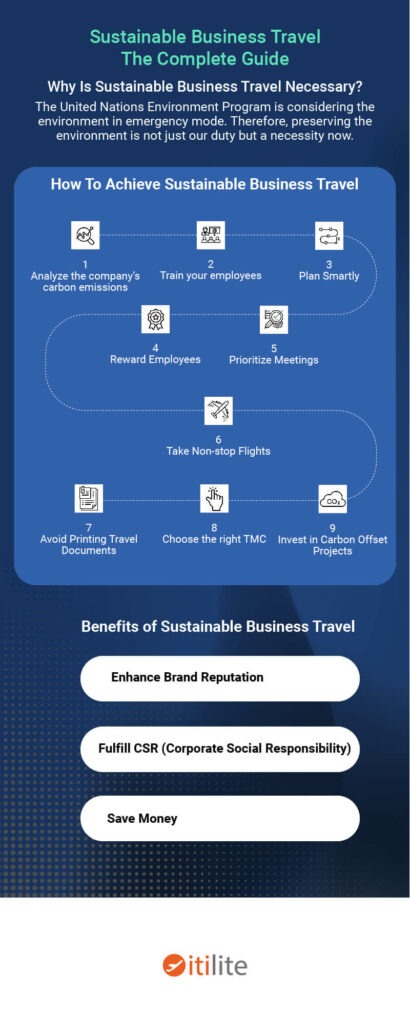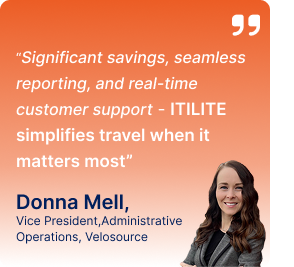
It is no secret anymore that our environment needs to be preserved. About two decades ago, sustainable travel would have been just a buzzword. However, in this day and age, it is a necessity. With several significant conferences this year, UNEP (United Nations Environment Program) is already considering the environment in emergency mode.
While everyone is making an effort to preserve the environment, the corporate world is too busy mending its way of functioning to include environmental sustainability in the mix.
One of the major aspects of corporate sustainability initiatives is sustainable business travel. It is an amalgamation of policies, procedures, and best practices aimed at minimizing carbon emissions due to any employee activity for business purposes.
To promote sustainability in business travel, thoroughly proofread your material two or three times before disseminating it to your employees.
Consequently, we’ve developed a customizable corporate travel sustainability template , which allows you to plan any trip within your company meticulously.
Grab your free Sustainable Travel Policy Template Now:
Check out this infographic about sustainable business travel.

Why is Sustainable Travel Necessary?
Employees frequently travel for client meetings, seminars, training, sales conferences, etc. Statista reported around 463 million domestic business trips and 5 million international trips a year before the pandemic.
These business trips can be local, somewhere within the country, or international. You can track the total carbon emissions caused by the business traveler on that business trip, which adds to the company’s carbon footprint in a corporate sustainable travel policy template .
Air travel is the most significant cause of business travel carbon emissions, constituting 2 percent of the total greenhouse emissions. Hotel stays are also environmentally harmful because the hospitality sector accounts for 1 percent of global carbon emissions. Additionally, factors such as local transport also contribute to environmental pollution.
Here are some factors that make business travel harmful to the environment.
- As most business travel is time-bound, travelers prefer faster modes of transportation like flights and cars over eco-friendly options like railways.
- The business class seats take up more space in an aircraft. Consequently, fewer travelers can be accommodated in an aircraft.
- Business travel makes up 12% of entire airline travel.
- 40% of hotel guests are business travelers.
How to Achieve Sustainable Business Travel?
Here are some practices that can help you achieve sustainable travel.
1. Analyze the Company’s Carbon Emissions
The first step toward ensuring sustainable travel is to analyze the company’s current carbon footprint. You can do so by hiring an external travel agency that keeps track of all your trips and measures your carbon footprint accordingly.
However, a better way is to adopt business travel management software that generates carbon footprint reports in real-time to help you identify which airlines to avoid.
2. Train your Employees
Employees are the ones that go on business trips. Hence, an essential step you can take to ensure sustainable business travel is to train the employees to follow environment-friendly practices while booking or during their trips.
For instance, you can encourage employees to opt for more sustainable modes of transportation, such as railways. Moreover, they should also prefer hotels certified for following green standards.
Additionally, you can also encourage them to pack eco-friendly items such as reusable water bottles and cloth napkins to avoid single-use items provided by airlines and hotels.
3. Plan Smartly
A business traveler needs to attend different events throughout the year. These events sometimes occur in the same location, roughly 2-4 days apart. Moreover, there are situations where multiple employees travel for a business trip, even though it is not essential for some to travel.
In such cases, you can plan smartly and club all these events in one business trip to ensure that the employee takes as few flights as possible. You can also prioritize the employees that go on a business trip on the basis of criticality.
Flying less can help the company reduce environmental damages by lowering CO2, GHG, and Nitrogen Oxide emissions. Moreover, it can also help you save a significant amount of money on business travel.
4. Reward Employees
Rewards and recognition can be great motivators for business travelers. You can offer employees rewards for booking the most eco-friendly travel options, following best practices to reduce carbon emissions, etc. Once the employees get into the habit of eco-friendly travel, the company’s carbon footprint will reduce significantly.
5. Prioritize Meetings
Business trips are essential. However, there are various conferencing solutions available that can easily substitute some meetings. Hence, as a decision-maker, you need to prioritize which business trips are essential for your business.
For instance, it’s better to attend a client meeting in person than over Skype. However, a press conference announcing a new product launch can easily be held on a virtual conferencing tool.
6. Take Non-stop Flights
A large quantity of fuel is expended when a flight takes off and lands as compared to when it is in the air. Hence, when you take multi-stop flights, more fuel is consumed on average compared to non-stop flights.
Hence, you should always prefer booking non-stop flights and encourage employees to do the same.
7. Avoid Printing Travel Documents
Another essential step you can take to incorporate sustainable business travel is to implement a company-wide “no-print” policy for travel documents. You should encourage your employees to use digital tickets and boarding passes.
Moreover, you can also invest in travel management software that stores digital copies of essential documents like the company’s business travel insurance policy, employees’ passports, known traveler numbers, and redress numbers. This way, your employees won’t have to make photocopies of their documents every time they travel.
Using digital documents instead of printed ones can help avoid excessive paper wastage and reduce your company’s carbon footprint.
8. Choose the Right TMC
If you are using the services of a travel management company (TMC), it is essential to enquire whether the vendors they deal with follow eco-friendly practices. You should also ask whether the travel management company follows a sustainable business travel program.
9. Invest in Carbon Offset Projects
Business travel is an inevitable part of a company’s operations. More often than not, employees must take long flights, which increases carbon footprints. However, you can counteract the negative environmental impact by investing in carbon offset projects.
A carbon offset project is an environmental initiative undertaken to reduce carbon emission levels. The projects involve introducing clean energy technologies to developing countries or planting more trees to soak up excess ecological carbon dioxide. Sponsoring a carbon offset program like Native Energy can help you balance your carbon footprint and curb environmental pollution.
Why do Businesses Hesitate to Adopt Sustainable Business Travel?
Adopting a sustainable travel model can be challenging in the beginning due to multiple reasons. Firstly, the entire business travel process needs to be analyzed, including the vendors, travel policies, and employee preferences, which takes time and effort from your end.
Secondly, the entire employee behavior needs to be revamped according to the company’s eco-friendly practices. For this, the company might also need to conduct training sessions to create awareness about eco-friendly travel practices among employees.
Finally, an economically feasible and easily adaptable business travel program needs to be developed. Otherwise, there is always a tendency to choose cost-effectiveness over sustainability.
What are the Benefits of Sustainable Business Travel?
Incorporating sustainability in your travel management process can be daunting. However, if you move past your reservations and adopt eco-friendly business travel practices, you can get a wide variety of benefits. Here is how sustainable travel can help your company:
1. Enhance Brand Reputation
Running a sustainable business travel program implies that you care about the environment. Customers, as well as companies worldwide, want to associate themselves with a company that has a “do-good” attitude. If you can think above the company’s finances and make an effort to sustain the environment, it speaks volumes about the company.
2. Fulfill CSR
CSR (Corporate Social Responsibility) is a management concept where companies are obliged to fulfill their social and environmental responsibility. By integrating the sustainable business travel program into their process, the companies can fulfill their CSR.
3. Save Money
Sustainable travel helps you save revenue in the long run as you encourage employees to opt for cheaper modes of transport, such as buses or railways.
Moreover, with sustainability practices, such as prioritizing meetings, consolidating multiple events in one trip, and using video conferencing software whenever possible, you significantly cut travel costs.
Sustainable Business Travel is the Way Forward.
Most new-age companies have started realizing the negative impact that their current business travel process has on the environment. This has led to the increased adoption of sustainable travel programs. With a corporate travel sustainability template, you can track and offset your carbon footprint.
If you want to implement sustainable business travel in your company, you need to evaluate the company’s carbon footprint per trip. itilite corporate travel management software offers advanced reports to measure your company’s carbon footprint so that you make informed decisions.
To check out the feature, just click on the link below.













